1lumen selects and reviews products personally. We may earn affiliate commissions through our links, which help support our testing.
Cyansky K3 review
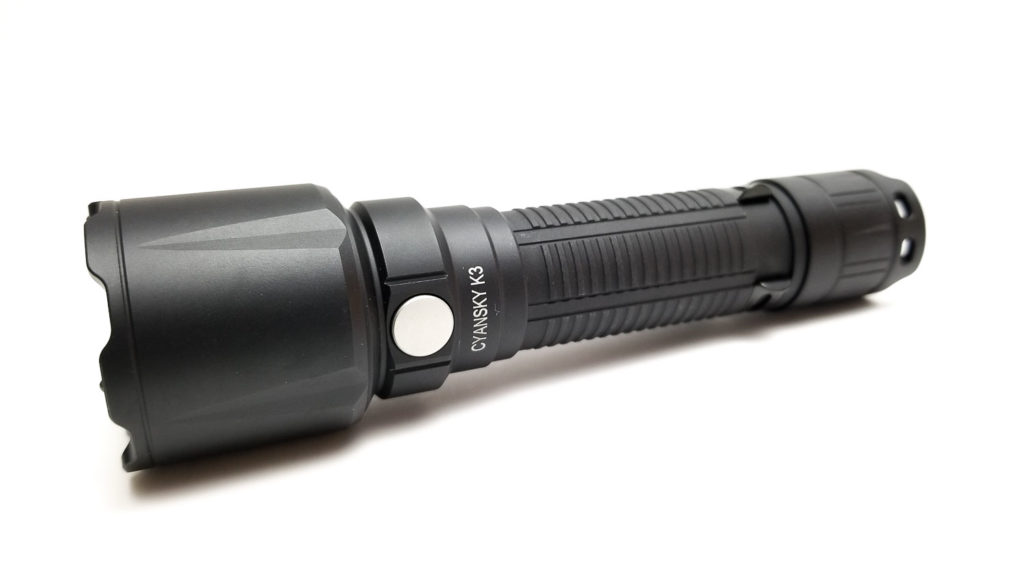
Cyansky K3 specifications
| Brand/model | Cyansky K3 |
|---|---|
| LED | Luminus SFT-40-W |
| Lumens | 1600 lm |
| Beam intensity | 90,000 cd |
| Battery config. | 1*21700 |
| Material | Aluminum |
| Modes | 5 |
| Blinkies | Strobe |
| Reflector | Smooth |
| Waterproof | IPX8 |
| Review date | July 2021 |
Introduction:
Note: the Cyansky K3 has been updated, and we reviewed it. Have a look at our Cyansky K3 v2 review.
Cyansky. Probably not a name you’ve heard come up very often, which makes sense because they are a relative newcomer to the flashlight oikos. How new? Back in January 2021, Dave reviewed the Cyansky H5, and that was the first time I’d ever heard of them. Interesting names aside, their offerings are innovative and high quality. Tactical flashlights are a big deal these days, with every Tom, Dick, and Harry seeming to offer one in some shape or form, including some great ones and unfortunately a lot of useless junk. Cyansky already has two decent tactical lights, but perhaps they wanted to diversify a bit, so today I’ll be taking a look at their newest light, the Cyansky K3. This promises to be a far-throwing tactical light, and I am super-duper excited about this one because the K3 is also sporting a new emitter making its debut in a mass-produced flashlight. Excited? I am, so let’s take a look.
Package quality.
I started having Acebeam flashbacks when I opened the mailer for the K3, with oras of Fenix mixed in. It’s apparent Cyansky follows the same packaging format. This is a retail package so it has a hang tag and the presentation is conducive to retail displays. The packaging is nice and formal with sharp graphics, eye-catching blue, and white colors, and feature blurbs galore. I really enjoyed the packaging. Inside, the light rides in a molded plastic carrier with all the accessories efficiently arranged underneath. Here’s what you get:
- Cyansky K3
- 2 spare o-rings
- Spare switch boot
- Lanyard
- USB A to C charging cable
- Cyansky BL2150U 21700 battery (loaded in the light)
- User manual
- Warranty card
- Holster
This is a proper assortment of accessories, including everything needed to get going. The battery has integrated charging which is important because most buyers of this light probably don’t have standalone chargers or 21700 batteries. The USB charging cable is very long at 24 inches, which is a bonus since most bundled charging cables are 12 inches or less. Thanks Cyansky. The lanyard is an odd design and looks like one that came bundled with a cheap monocular I got in the early 1990’s. I’m sure it works fine but seems a bit out of place here.
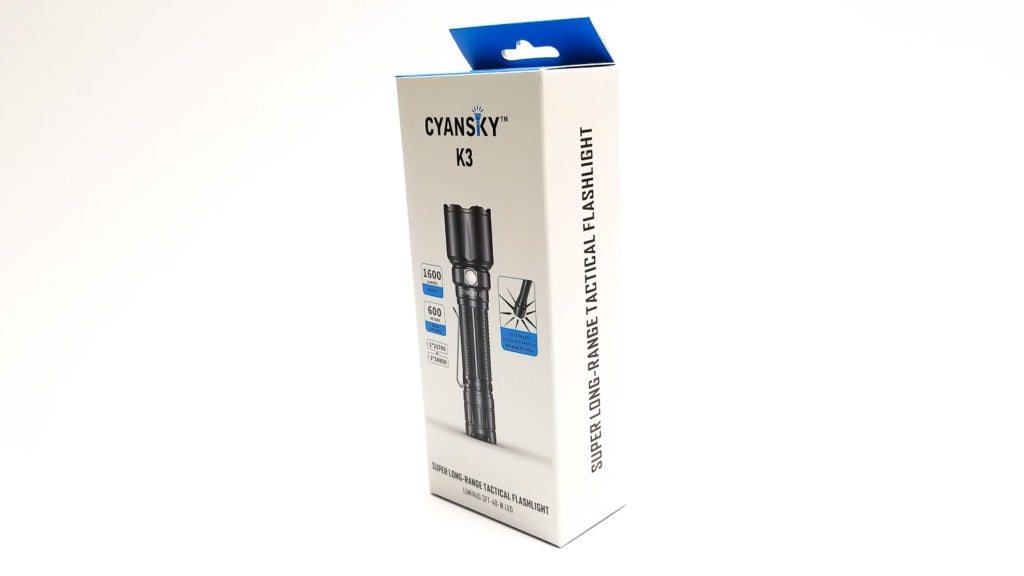

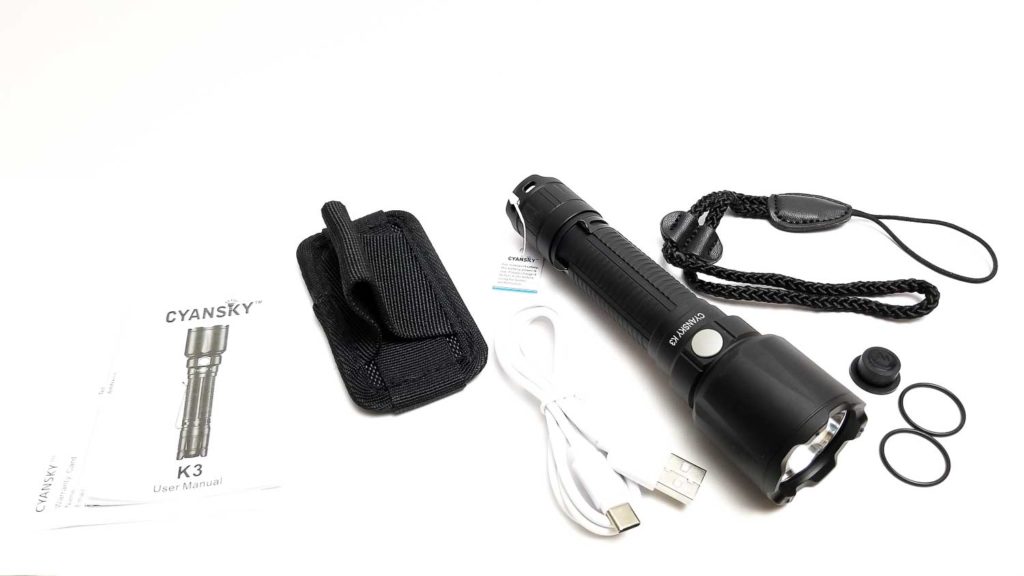
Flashlight in use
As a light meant for professional use, the Cyansky K3 adopts some design elements from Fenix, and that’s just fine with me. Imitation is a high form of flattery, right? It’s almost like the Acebeam L17 and Fenix PD35 got into a transporter accident, were melded together and the K3 materialized. This is a 21700 form factor light so naturally, the handling is very natural and fits most hand sizes, including my large hands. I’d say it handles a lot like a C8 with a side switch and pocket clip.
The finish and interesting gripping texture on the battery tube make for excellent controllability in all grip positions; underhand, overhand, and tactical. Even though there’s no tactical ring with this, I could still hold it fine in a cigar grip. For the switching, there’s a rear mounted forward clicky switch combined with a side e-switch (just like Fenix). The rear switch is for power and momentary use while the side switch is just for mode changes. The click action on both is very good, with great tactile and audible feedback. The e-switch is a step above the Acebeam ones I compared it to since it didn’t feel mushy and there’s just the right amount of travel. I could easily find the switch by feel. Tailstanding is no problem either.
The removable pocket clip allows bezel up or down carry, and it was clipped on pretty tight, requiring a good deal of effort to remove. It has good tension though and should stay secured to whatever you clip it to. Cyansky also includes a somewhat abbreviated version of a holster that doesn’t fully enclose the light, but merely secures it to your belt for use without the pocket clip. It’s kind of inconvenient since you need to take off your belt to mount or dismount the holster.
In keeping with the tactical theme, it wouldn’t be a true tactical light without tactical accessories for mounting to a rifle or shotgun. Cyansky offers a few options for that, including the RS02 remote switch, GM02 quick detach Picatinny rail mount, GM03 combo mount (with threaded mount), GM06 combo mount and GM09 M1913 Picatinny mount.
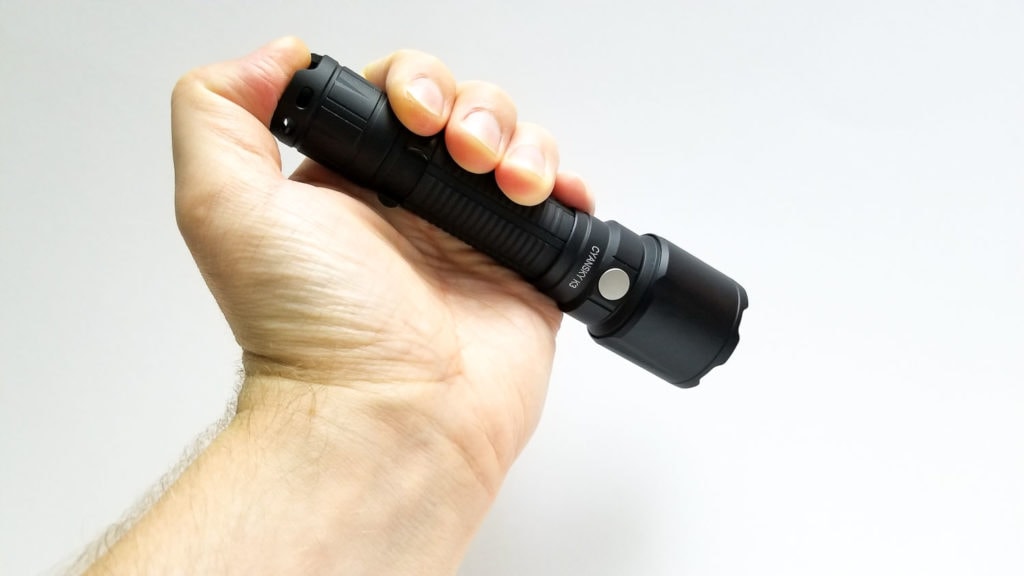
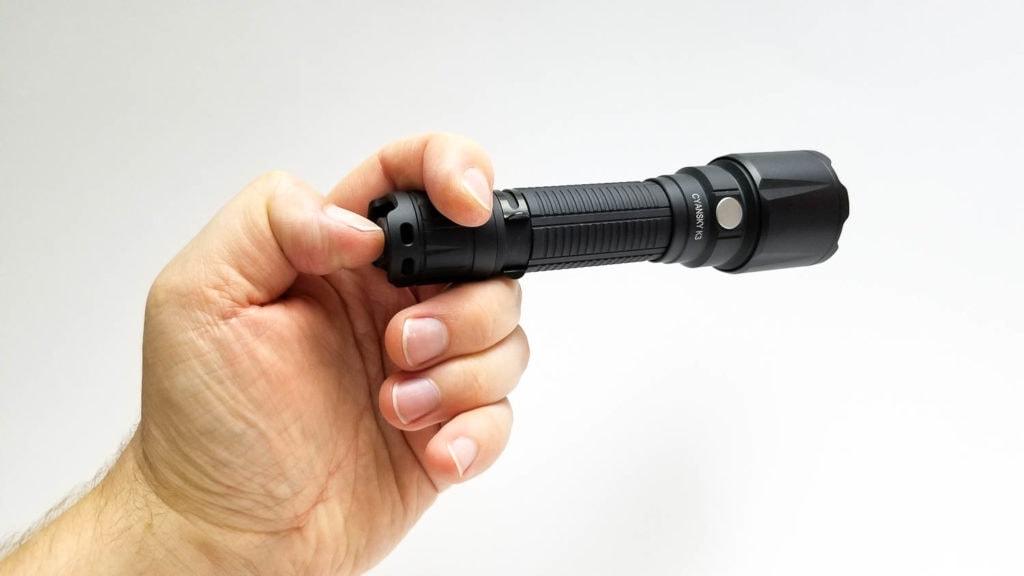
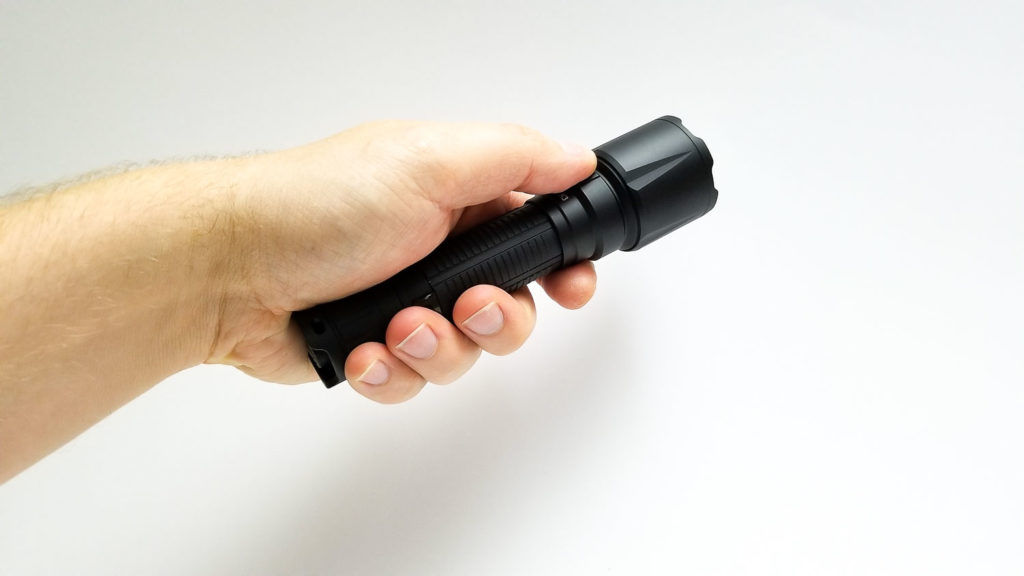
Build Quality, and Warranty
This is my first go-around with a Cyansky light, and first impressions are very, very good. The first time I handled the Cyanksy K3, the quality, fit, and finish are unquestionably on par with anything from Acebeam and Fenix. There were no defects in the machining, no burrs or tool marks, and all the parts fit together precisely with no gaps. All the edges are beveled with no sharp edges. The K3 definitely feels like a quality item and for the level of fit and finish also represents a good value. I did notice a perfectly-centered round area that looked like a smudge on the inside of the lens, but I don’t know if that’s what it is since it’s too perfect to be there by accident. It doesn’t affect the beam at all though, and only noticeable when holding the light at a certain angle.
The light is constructed from A6061-T6 aluminum alloy with black typeIII HA anodizing, and I must say it’s about as good as it gets. It’s nice and matte, and feels amazing in the hands. Very grippy. It’s not like a brick texture, but somewhere in the middle. It’s perfectly done also: no blemishes or thin areas with excellent coverage.
The light breaks down into four parts: head, battery tube, pocket clip, and tailcap. The bezel is integrated with the head, which seems glued on. The tailcap has a single very long gold-plated and decently thick spring mounted on a PCB held in with a substantial aluminum retaining ring. The driver side has a brass button for the battery positive contact and I’m a bit surprised with this choice since this light is able to be mounted on a rifle or shotgun. Under repeated recoil, a solid positive contact might cause damage to the battery or driver, so I think a spring might be a better choice here. The K3 won’t roll away if left on an inclined surface since there are anti-roll cuts in the head, and it passes the Maracas test with flying colors: no rattles.
The front and rear threads are rectangular, thick, and very precisely cut. They are also fully anodized and this makes locking out the light possible by unscrewing the tailcap ever so slightly. Cyansky worked some Jedi magic on the current path because there’s no inner sleeve like Acebeam uses on the clicky/e-switch lights, which is nice because it’s one less item to potentially fail. The threads weren’t lubed that I could tell (unless it’s graphite) and weren’t super-smooth, but not gritty. Once lubed, they were very smooth. The battery tube is sealed at both ends by a single o-ring, and Cyansky gives the light a generic IPX8 rating, so it should be good for temporary immersion up to 2 meters.
Although relatively new to the market, Cyansky backs up their quality with a great warranty that rivals the competition: 15 days no hassle free return and refund for defects, 5 year (60 months) free repairs for factory or manufacturing defects, and a limited lifetime warranty with covered labor for repairs (customer covers parts) after 5 years.
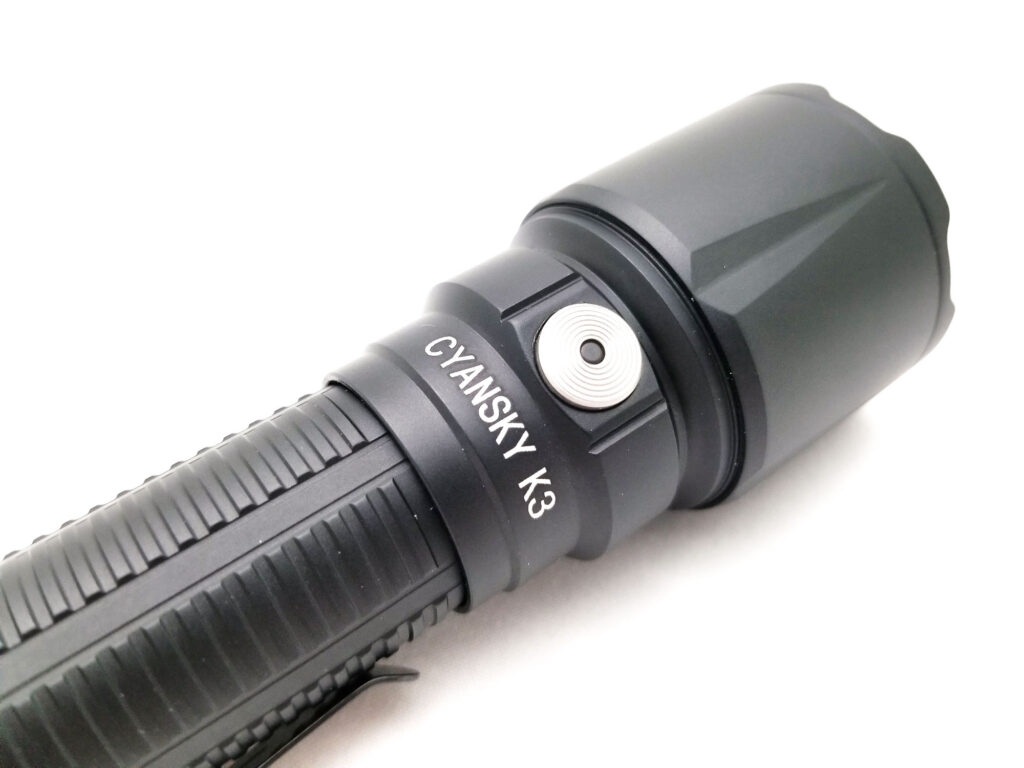
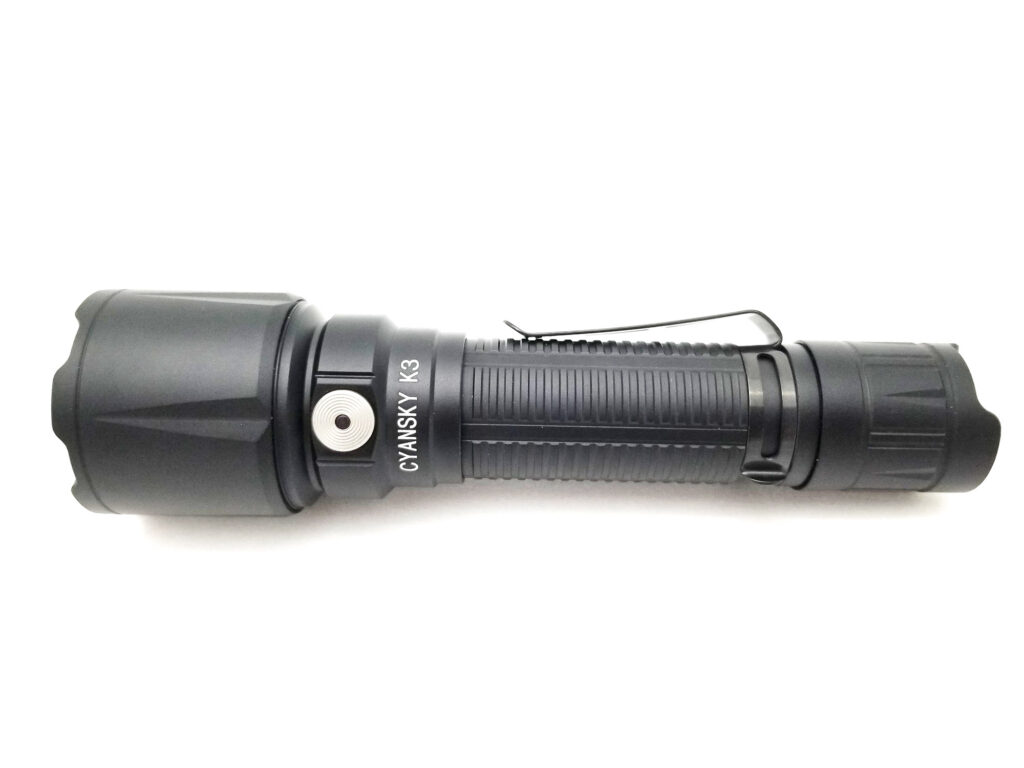
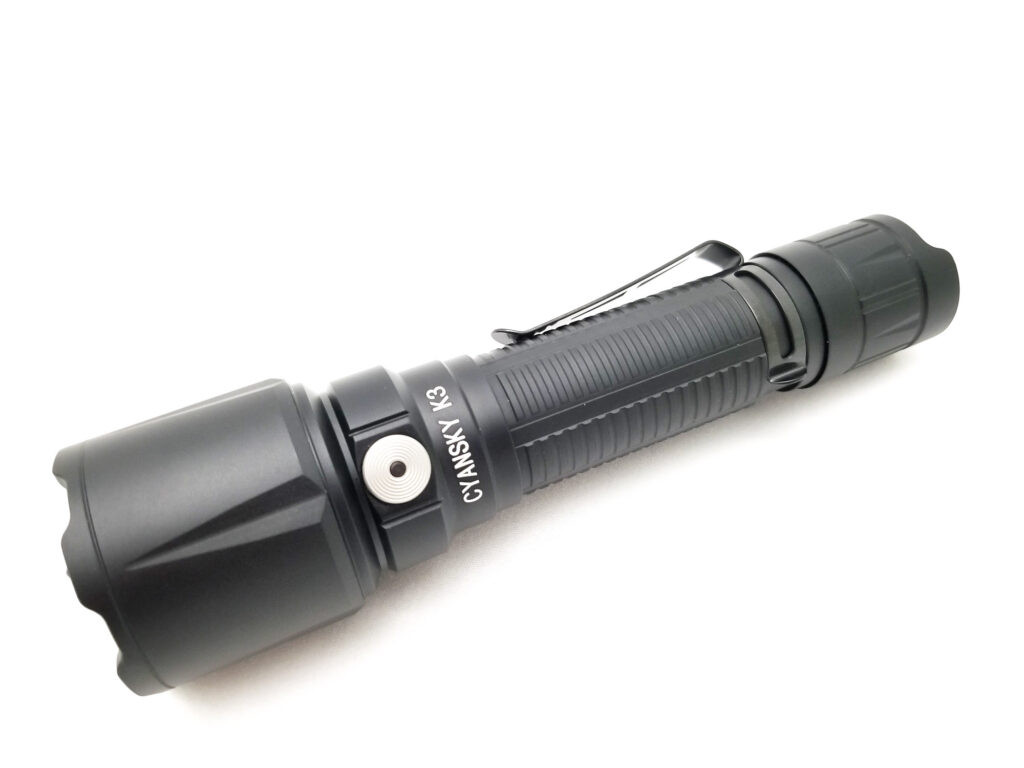
LED, Lens, Bezel, and Reflector
The LED really is the showpiece of the K3. It features an LED which was, until recently, a relatively unknown emitter, the Luminus SFT-40-W. In fact, Cyansky holds the title of the first manufacturer to mass produce a light with this emitter (Convoy’s SFT-40 lights came later).
The SFT-40-W is a 3-volt domeless emitter based on the 5050-size footprint, so it’s interchangeable with an SST40, XM-L, or 3 volt XHP50.2 It’s capable of higher output than an XP-L HI and even beats the Osram W2 and Boost HX in output. Cyansky doesn’t give the CCT, but since the SFT-40-W predominantly comes in 6500K, we’ll go with that. Before delving into the design, let’s get the elephant out of the room: This is not a dedomed SST40. It’s not a flip chip either (like the Osram domeless emitters), and instead of two bond wires, there are four: one on each corner of the die. No dome means higher surface brightness (cd/mm2) and a tighter beam. This improves throw quite a lot over a domed emitter.
The LED is perfectly centered in flawless smooth aluminum reflector topped with a toughened mineral glass lens with AR coating. I did notice an odd circular pattern that looked like a fingerprint which was barely discernible in the center of the lens. I don’t know if it’s meant to be there or not, but it’s not a fingerprint, and it’s not noticeable. It might be a reflection off the surface of the LED’s die. The bezel is integrated with the head and carries forward the tacticool blacked out theme. It looks similar to the Fenix TK16 V2.0 bezel as it’s aggressively crenulated and has 3 embedded zirconium breaking tips. Zirconium is one of the hardest materials besides diamond at between 9 and 9.5 on the Mohs hardness scale. These are for breaking vehicle windows or force-multiplication in defensive situations. I‘d test that, but I don’t have a spare window to break, so I can’t test this, but I’m sure it would break windows with aplomb.
The beam is about what I expected, with a sharp, focused hotspot and abundant spill. It’s a very versatile and useful beam, not an all out thrower for sure, but it definitely throws farther than my TK16 V2.0 and my C8 with SST40. It’s pretty close to my Acebeam L17, which I tested at over 600 meters of throw, but the K3 has a more useful beam. The reflector is tuned very well for the SFT-40 LED. There’s no visible tint shift or corona, and although the beam is free of artifacts, the aggressive bezel does show up in the spill perimeter. Also, I didn’t notice any green tints at low output like I get with some SST40’s, and the tint seems to be cool white, but maybe a little warmer than the Osram-equipped Acebeams I have.
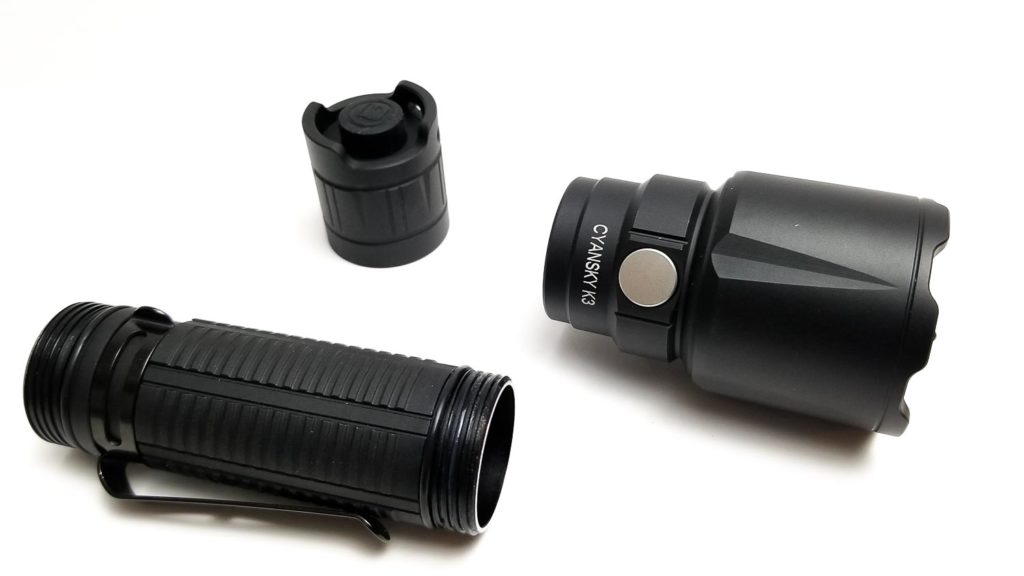
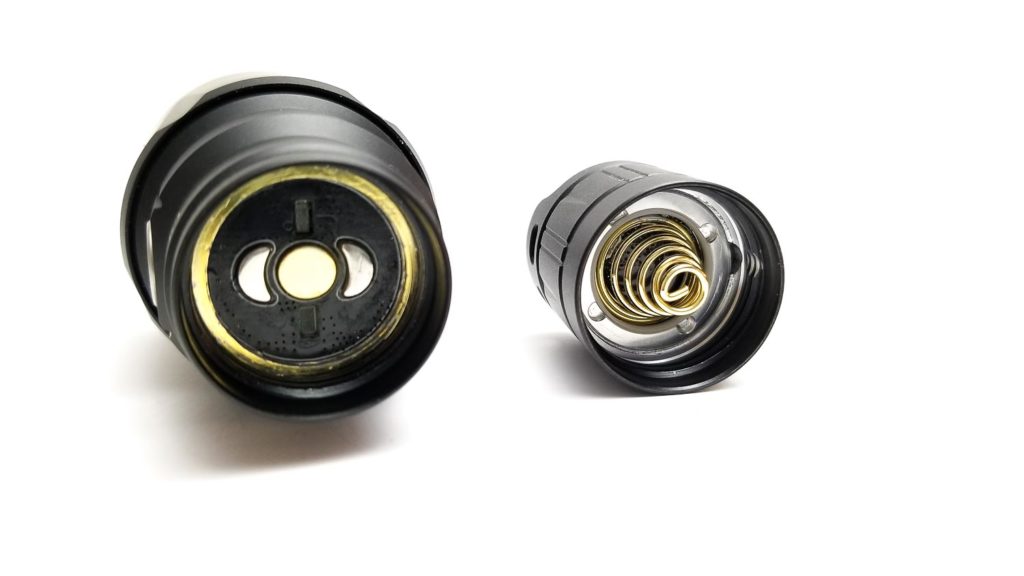
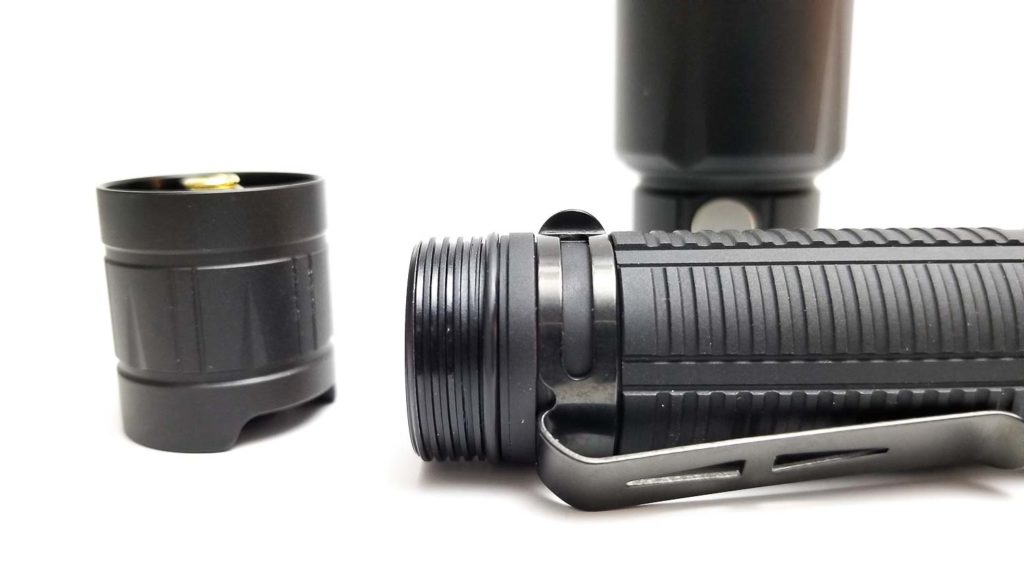
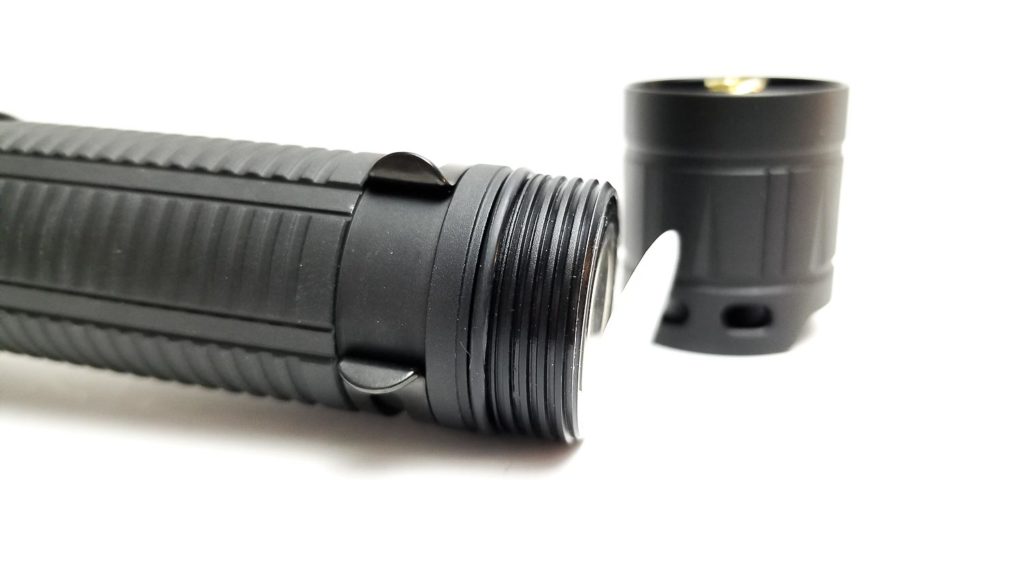
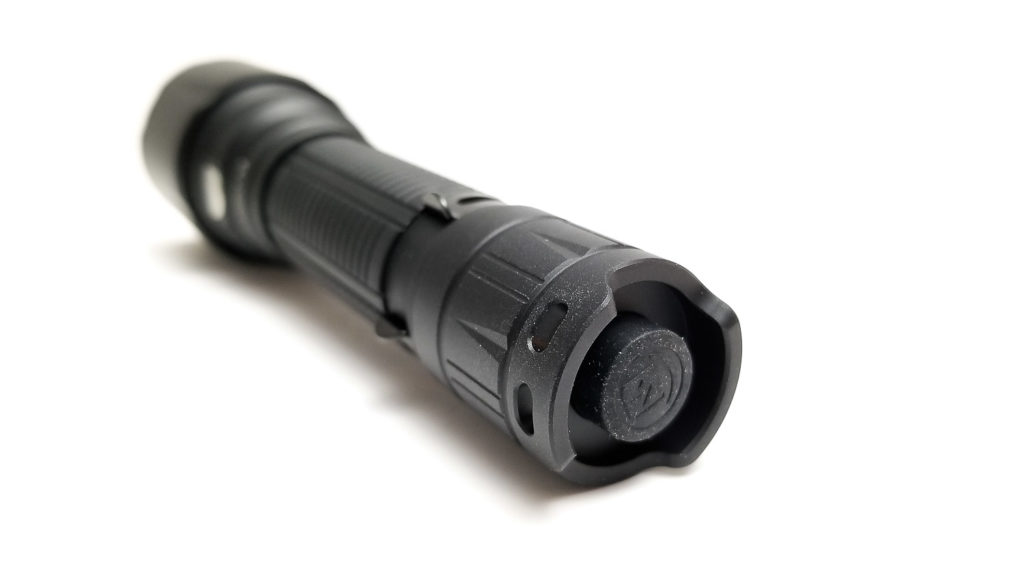

Dimensions and size comparison
- Length: 15.1 cm / 5.94 inches
- Head diameter: 4.0 cm / 1.57 inches
- Body diameter: 2.54 cm / 1 inch
Weight:
- With the included 5000 mAh 21700 battery: 206.8 grams / 7.29 oz.
- Without battery:133 grams / 4.69 oz.
Flashlight size comparison
The K3 is pretty close in size to a C8, but a bit larger than the Acebeam L17. Left to right group 1: Cyansky K3, Fenix TK16 V2.0, Olight Odin, Acebeam L18.
Group 2 left to right: Thorfire C8, Acebeam L17, Cyansky K3.
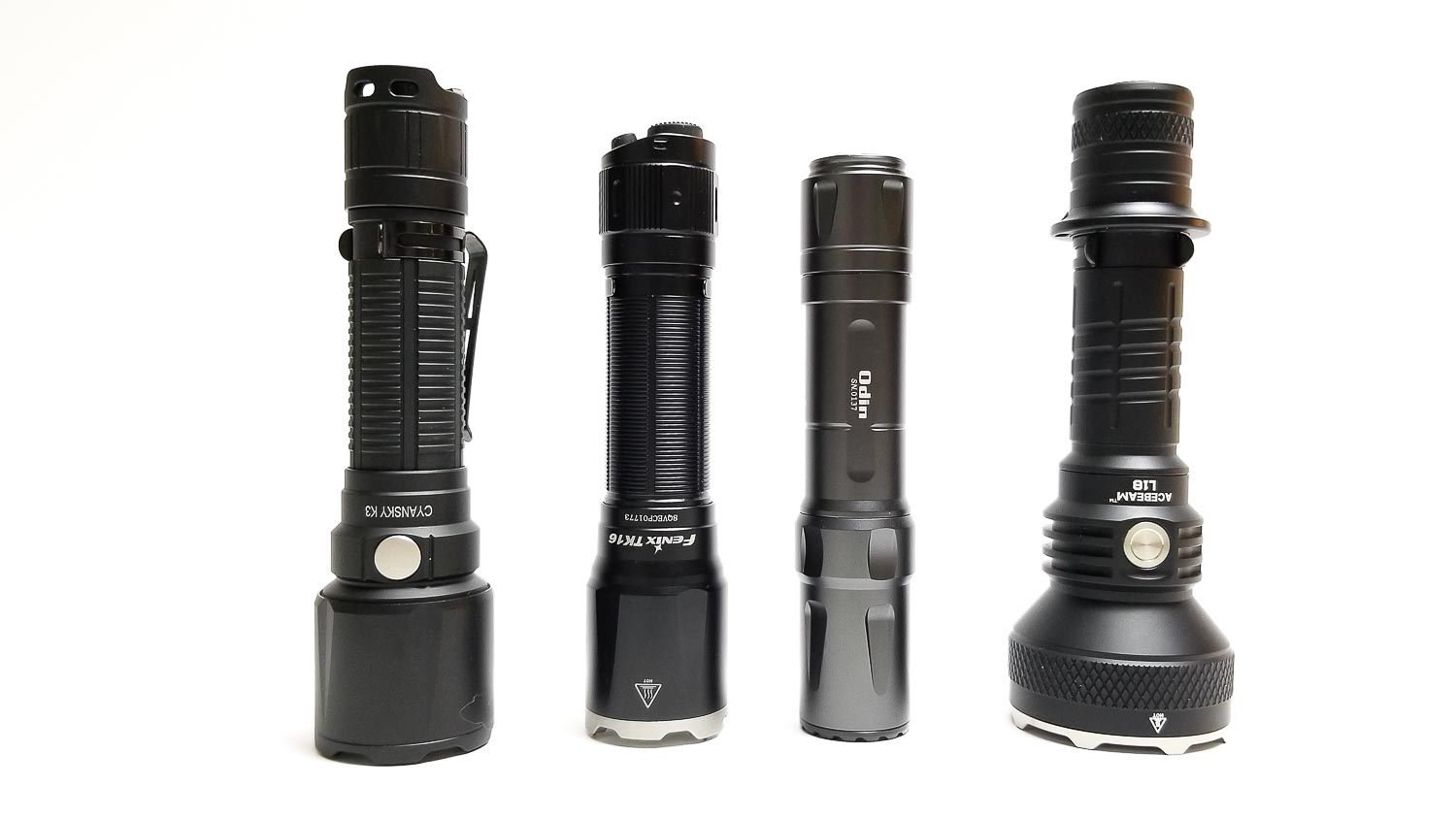
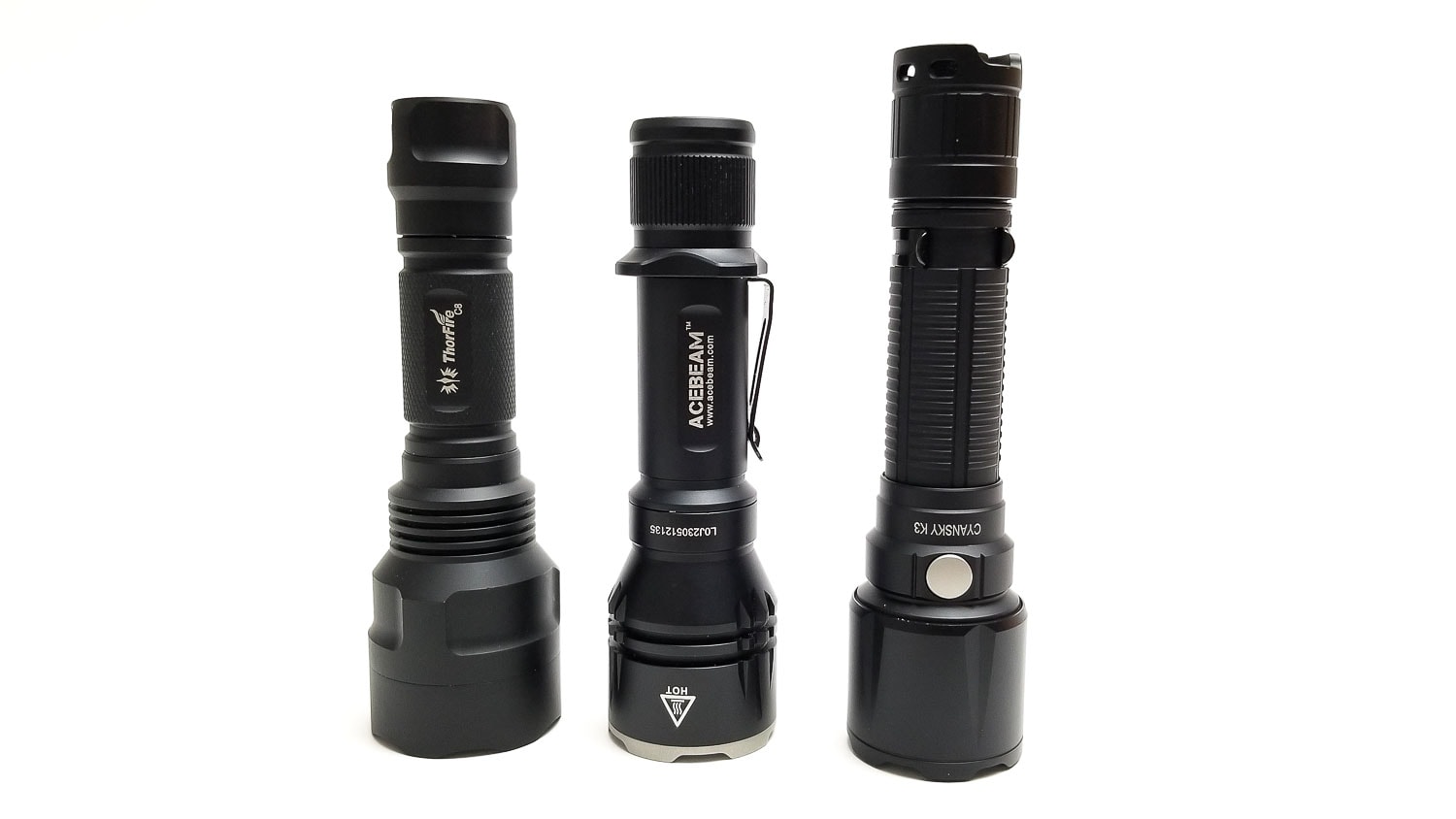
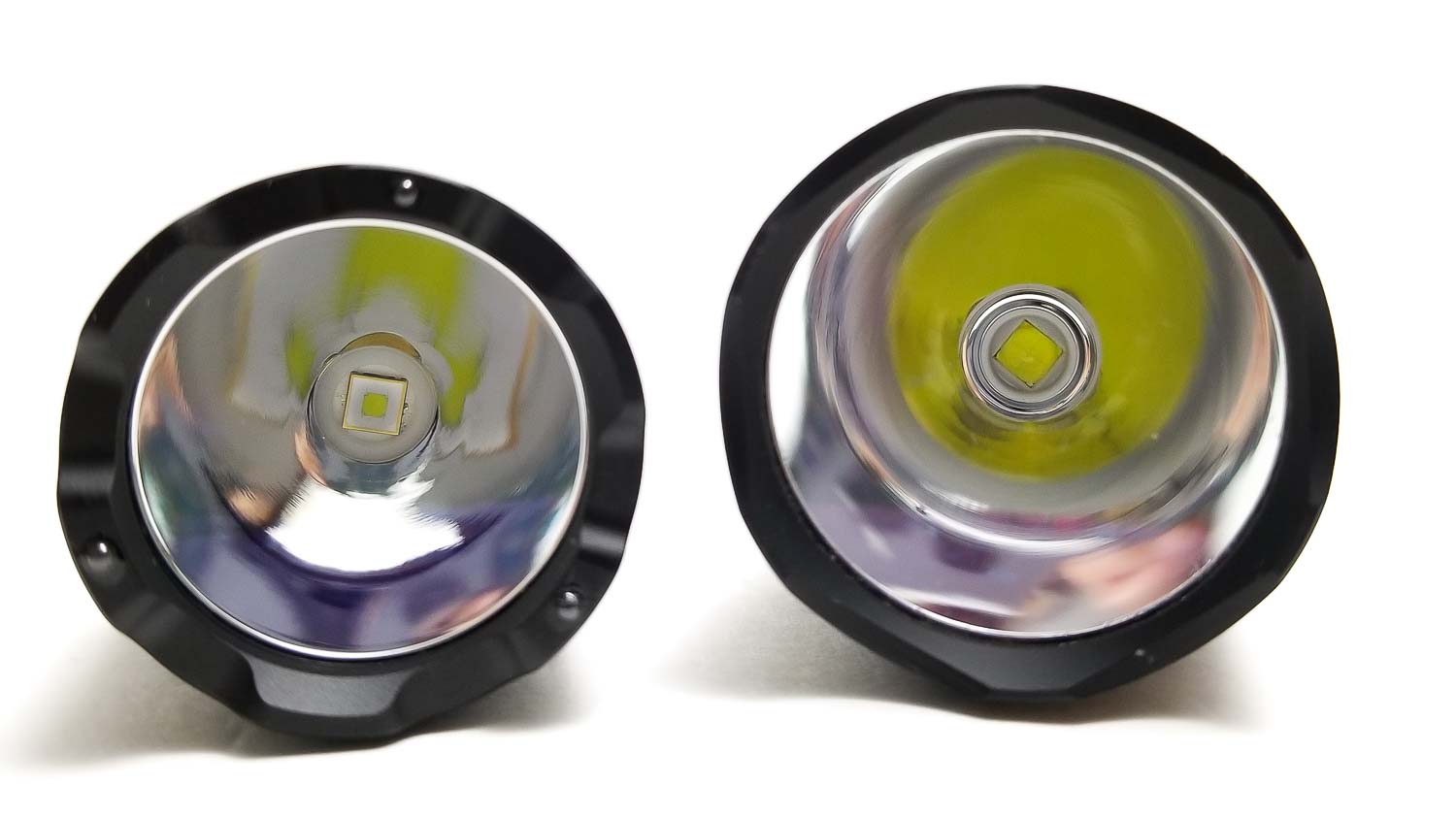
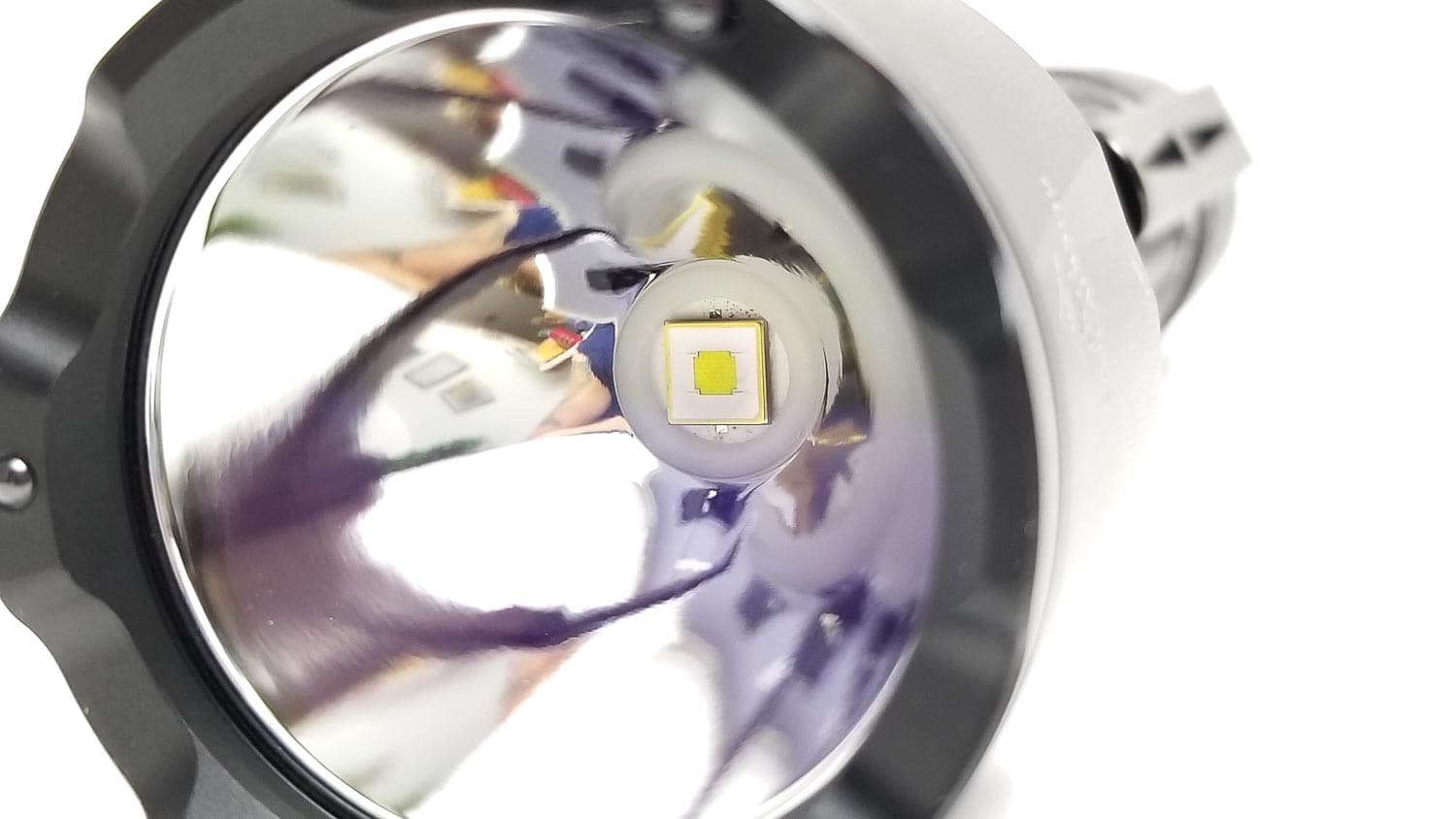
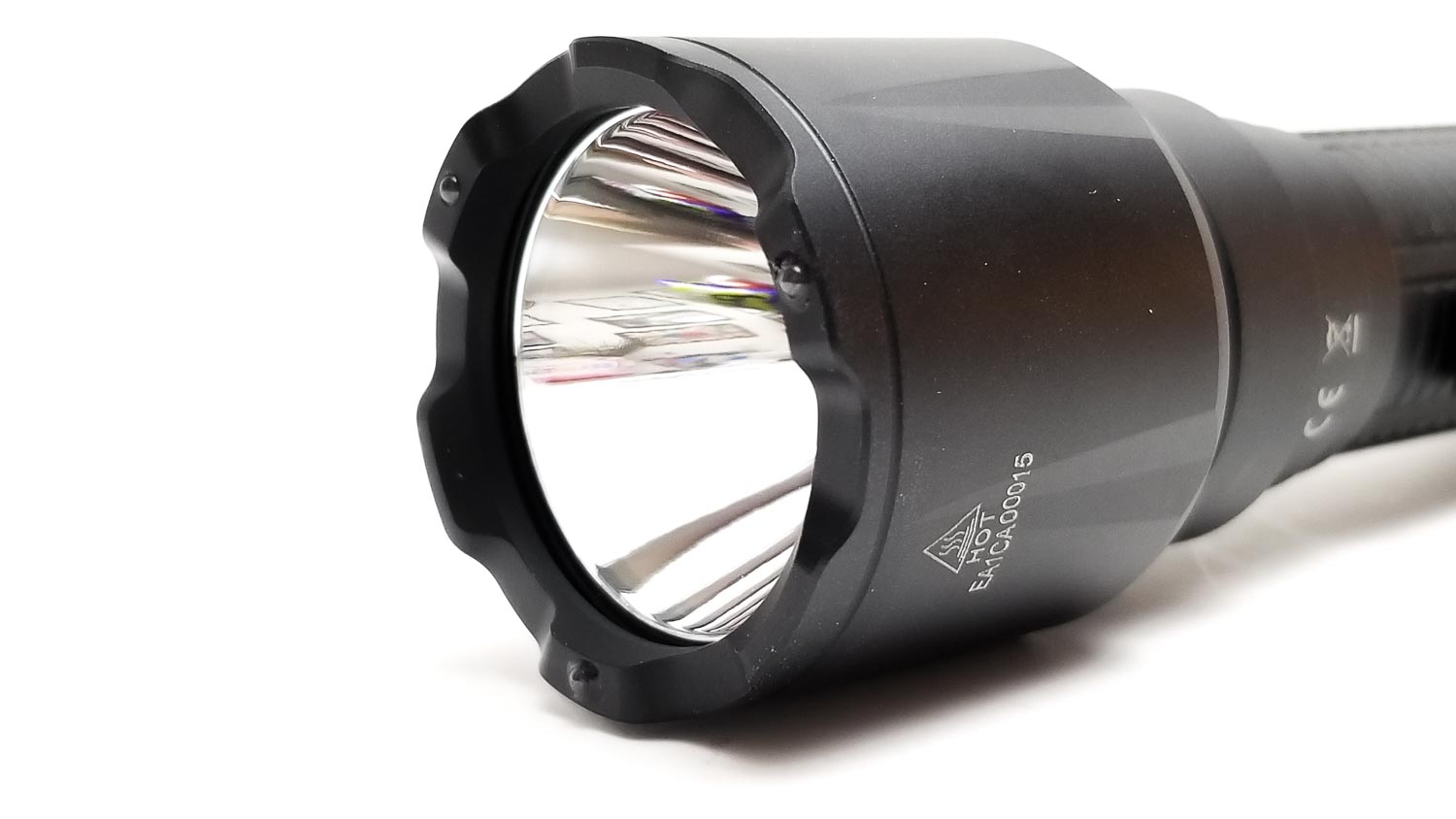
Driver & User Interface:
The driver is a bit of a mystery, but it seems to be a buck driver since the K3 can take two CR123A batteries like most serious tactical lights can. It has physical reverse polarity protection and LVP with a timed step down on turbo and temperature regulation on the other modes for temperature control. The UI is pretty straightforward tactical light fare with 5 total modes including a variable strobe.
Modes: Low, medium, high, and turbo with a single strobe.
From OFF:
- Click and hold side switch: N/A
- Single click rear switch: Turns on in last mode
- Double click front/rear switches: N/A
From ON:
- Click and hold side switch: Strobe
- Single click side switch: Changes to next mode (L-M-H-T)
- Single click rear switch: Turns off
- Double click: N/A
Mode memory:
- Yes, last mode memory. Strobe is not memorized.
Low voltage warning:
- Yes. When the battery hits 3 volts, the brightness will step down very low until the light shuts off.
Strobe/blinkies
- Single variable strobe
Lock-out mode:
- None. Unscrew the tailcap ⅛ turn to lock out.
PWM
- None.
Additional info: I’ve said it before and I’ll say it again: Complex or difficult to use UI’s do not belong on professional-use lights, ever. You should be able to pick it up, turn it on, and change modes without hassling with ramps, double, or triple clicks. That said, the K3’s UI definitely fits into the keep-it-simple category with simple modes, however, the difference between High and Turbo modes are pretty negligible, so maybe some tweaking is needed there. There’s a timed (60 seconds) step down for turbo, but the other modes are controlled by Cyansky’s version of ATR.
I like that strobe mode is available in any mode with a press and hold of the e-switch, and there’s no double or triple-clicking required. I also like the fact that when the light is off, it really is off so you can’t accidentally turn it on. However, I think strobe mode should be available from the off position without having to click the rear switch since in a tactical situation you might forget you need to turn the light on first! Also, I think this should have a turbo tactical mode, where the rear clicky always activates turbo instead of the last used mode, and there should be a way to instantly access strobe from off. I like that there’s no electronic lockout either since forgetting the light is locked can be bad. Overall, it’s a nice UI for a professional-use light like this.
Batteries & Charging
Cyansky followed the crowd again with the battery arrangement and charging. The K3 is future-proof for battery tech and designed for a single 21700 lithium-ion cell, but can also accept two CR123A cells or a single 18650 (per the manual anyway). Cyansky bundles the K3 with their BL2150U battery, which is a button-top 5000 mAh 21700 cell with built-in USB type C charging. There’s a tiny hole in the button top for the charge indicator LED: Red for charging, green for charged.
I got deja-vu a bit when inspecting this battery since it does look remarkably similar to the one Fenix includes with their lights, so maybe it’s the same cell with a different wrapper. The good news is this isn’t a proprietary battery, so you aren’t limited to a single battery from the manufacturer. This isn’t a huge deal for the average user who could care less about different battery capacities, and 5000 mAh is the highest capacity cell currently for 21700, but for enthusiasts who like to swap cells with ones they have on hand, this is a big deal, so major kudos to Cyansky for that.
A word about the 18650 cell compatibility: An unprotected flat top will not work. Period. It’s too short and the back of the driver has interference bars for reverse polarity protection anyways. A protected Acebeam 18650 button top with USB charging I had worked, and so did a button top Epoch brand 21700. I don’t have any CR123A cells to try, but as long as you’re coming in around 71 mm for cell length, they will fit. You will pay an output penalty on the CR123A cells though.
Since the battery has built-in charging, you don’t need a separate charger, but you could charge this battery in an appropriate charger that takes 75 mm long cells. The charging current on the cell was around 1.5 amps per my USB meter. Not that great considering this is a 5 Ah cell. It took a few hours to fully charge, so don’t expect quick recharges.
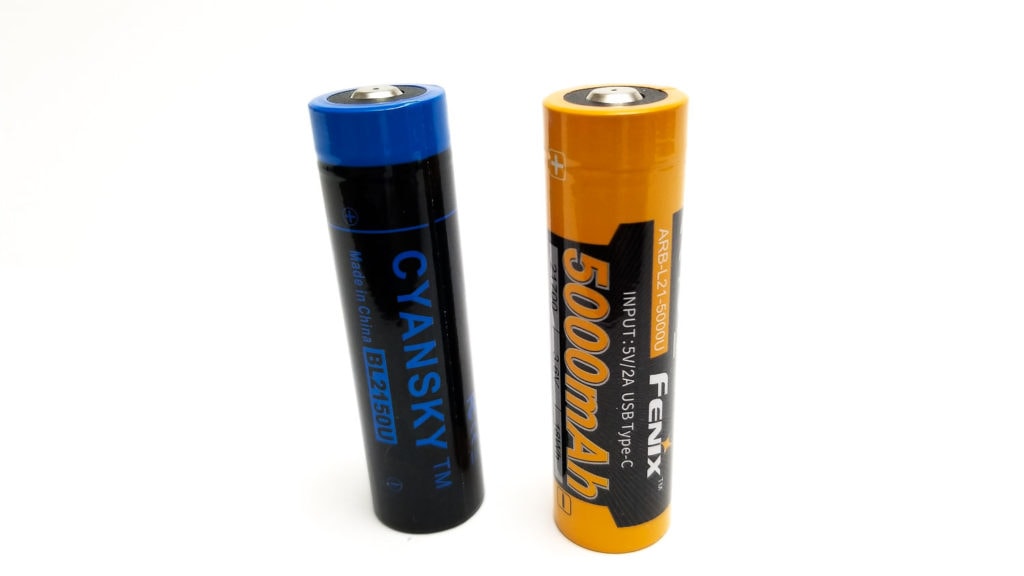
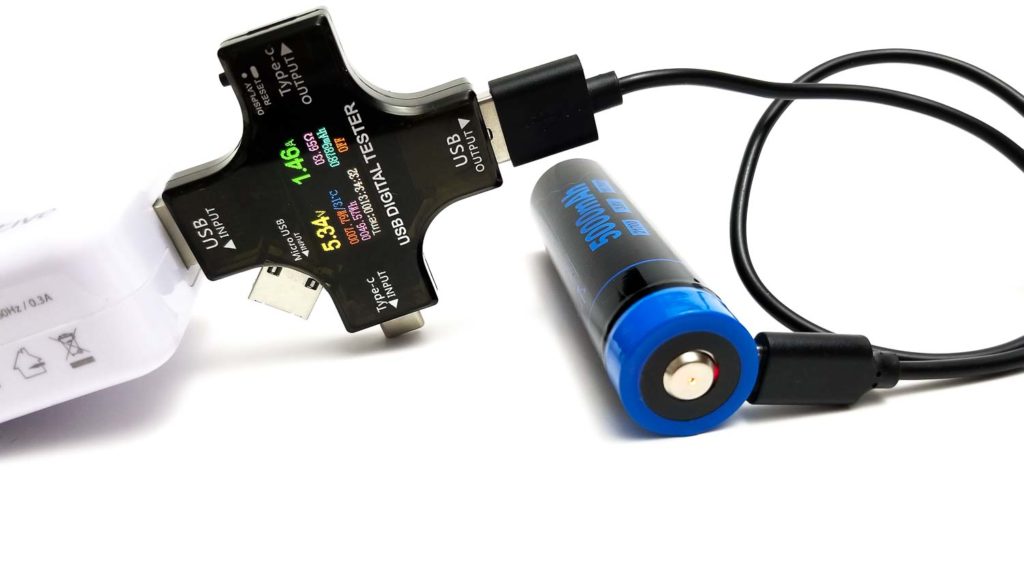
Performance
Time for the Cyansky K3 to prove its mettle! It’s competing against some proven heavy-hitters in this class, so maybe the extra throw will elevate it over the competition.
Amp measurement
- Low: 40 mA
- Medium: 340 mA
- High: 1.74 A
- Turbo: 5.6 A (at turn on)
Parasitic drain:
0.20 mA
Runtime graph
I conducted the runtime test using the 30 centimeter integrating sphere with the Digi-Sense 20250-00 data logging lux meter. I used the fully charged Cyansky BL2150U 5000 mAh battery and tested Medium, High, and Turbo modes. No testing for Low since it’s claimed to run for 100 hours.
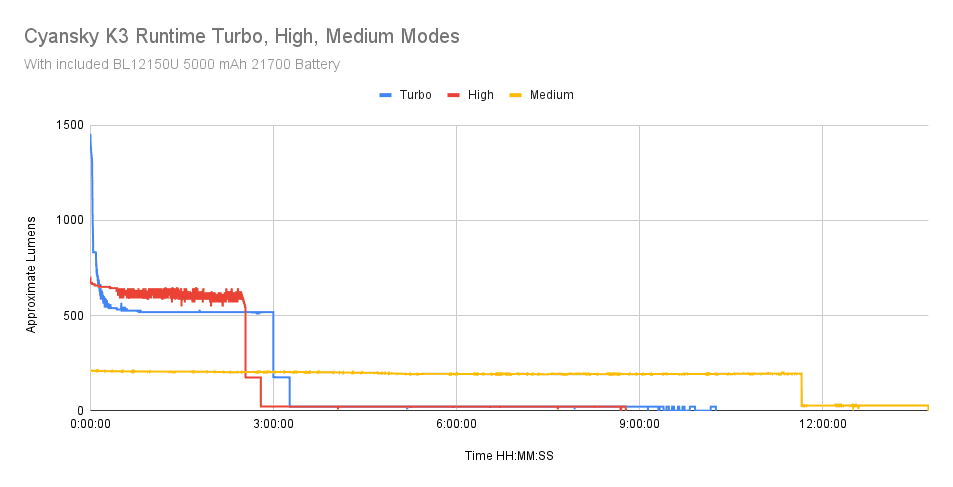
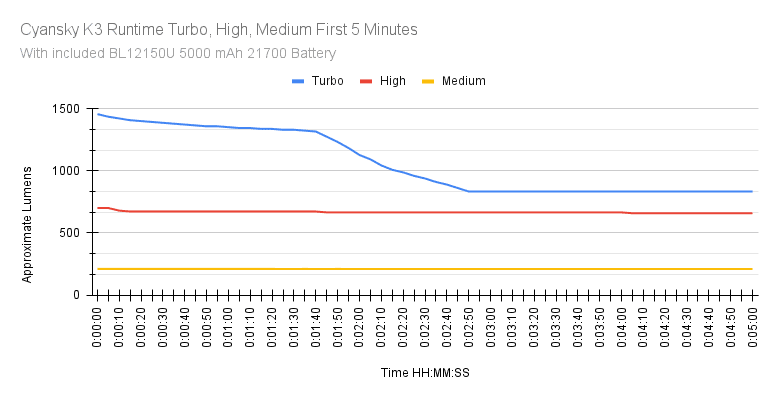
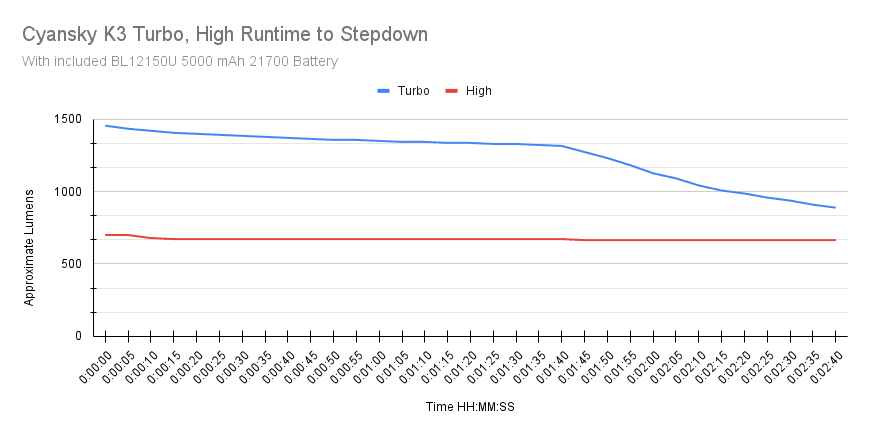
Turbo mode started at a little under 1500 lumens, down from the advertised 1600. I was expecting an abrupt step down at the 60 second mark (or thereabouts), but saw nothing of the sort. Hmmm. What I did observe was a nice subtle decrease in output until about the 2 minute 15 second mark, when the output dropped below 1000 lumens. The K3 did well in sustaining 1200+ lumens for almost 2 minutes. This is more than enough light for ‘tactical use’ when spotting long-distance objects. The output gradually decreased in defined steps until it hit 518 lumens, where it stayed rock-solid for 2 hours and 11 minutes before stepping to 175 lumens at 2 hours 59 minutes. It stayed there until the 3 hour 15 minute mark, where it stepped way down to 21 lumens (essentially low mode), where it stuck until the light shut off at 9 hours 23 minutes. Whew! Cyansky specs a 2 hour runtime, and this is a bit confusing since at the 2 hr. mark the light is still making 518 lumens? This behavior is more akin to Anduril, with temperature regulated output followed by a deep stepdown and long runtime until LVP pulls the plug. For temps, I never saw over 50 C, and temps peaked at between 5 and 10 minutes into the run, so heat is not an issue for this light and would be safe to use for extended periods.
High started at 700 lumens, and didn’t really decrease much until the 2 hour 32 minute mark, when it stepped down to 175 lumens just like Turbo mode did. From there, 14 minutes later the output dropped to 21 lumens (again, low mode), where it stayed until I ended the test at the 8 hour 46 minute mark. I knew it would have run for another couple hours at this output. The drop from start to the last step down was only 160 lumens, so thumbs-up for that! Temperatures weren’t an issue either with the same 50 C ceiling and the regulation was very good with no radical fluctuations in output. Cyansky’s advertised runtime is 3 hours for High, so if we correlate the 175 lumen stepdown mark, it’s pretty close.
Medium started at 210 lumens and in true CC buck driver fashion, held that output forever. Well, it seemed like forever, since the output didn’t drop below 200 lumens until 4 hours and 18 minutes into the test. The output stayed at around 200 lumens until the 11 hour 39 minute mark, where the output dropped to under 30 lumens (yep, low mode), and stayed until I ended the test at the 13 hour 43 minute mark. Cyansky’s runtime figure? 12 hours.
I could go on and on about boost/buck, constant current, constant voltage, temperature regulation, timed stepdowns and so forth, but for the Cyansky K3, I think they did a good job with the driver regulation and drive current selection. This isn’t an all-out enthusiast light, so they weren’t gunning for max hand-melting output, but, I do think Cyansky could have bumped the drive current a bit to get a little more out of it since the host didn’t get very warm during the turbo test. Since this light is sealed, modding might not be an option either. Alas, what we do get are long runtimes, nice regulation, and good temperature management. I didn’t see a 60-second step down for Turbo as specified, and that’s fine with me. I think this is fine performance for a working-class light. The modest drive current, good regulation, and long runtimes are great for law enforcement or security officers who need a light to last for the whole shift.
Lumen measurements (for each mode)
For the lumen tests, I used my home made 30 cm integrating sphere calibrated with a light of known output using the Digi-Sense 20250-00 data logging lux meter. I used the included fully charged 5000 mAh battery. Readings were taken at 30 seconds.
| Mode | Measured Lumens | Advertised Lumens |
| Low | 28 | 30 |
| Medium | 210 | 200 |
| High | 700 | 800 |
| Turbo | 1456 | 1600 |
The numbers look good. Down a little on High and Turbo from advertised, but if you compare this to other domeless emitters, it’s a different story. The SFT-40-W beats the XP-L HI and Osram CULPM1.TG in output. Plus, it really isn’t being driven all that hard.
Throw numbers:
Throw was measured at 10 meters using the Uni-t UT383S lux meter. I used the included BL2150U 5000 mAh battery for all tests. Readings were recorded at 30 seconds.
| Mode | Measured Throw | Advertised Throw |
| Low | 1850 cd, 86.02 meters | 113 cd, 21 meters |
| Medium | 14,475 cd, 240.62 meters | 5133 cd, 143 meters |
| High | 56,475 cd, 475.28 meters | 45,010 cd, 425 meters |
| Turbo | 95,100 cd, 616.76 meters | 90,000 cd, 600 meters |
As you can see, there’s quite a big difference between my Low cd and Cyansky’s Low cd. I am not sure why this is since I tested it twice and got the exact same reading. All my other numbers are coming in higher than the rated throw, so I’ll take it. In fact, compared to the Osram W2-equipped Acebeam L17, the K3 isn’t off by much in throw.
Beamshots
I compared the K3 to a C8 with a FET-driven SST40, the Acebeam L17, and the Fenix TK16 V2.0
- Outdoor shots: For the first pictures, the water tower is about 90 meters away. In the second set, the fence is about 40 meters away. The end of the hallway is about 10 meters distant. We can see how the lights with reflectors differ from the L17 which has a TIR optic. The K3 is for all intensive purposes neck-and-neck with the L17, which is impressive since it throws almost 700 m. The C8 with SST40 does well, and the TK16 V2.0 does well, but comes up short. I’m really impressed with the SFT-40-W. It really throws well and has a very useful beam.
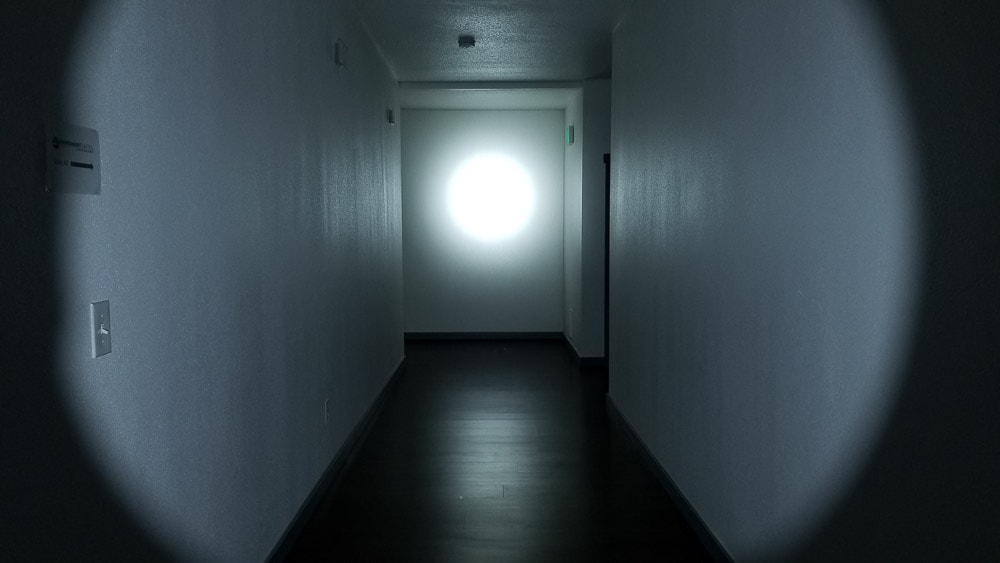
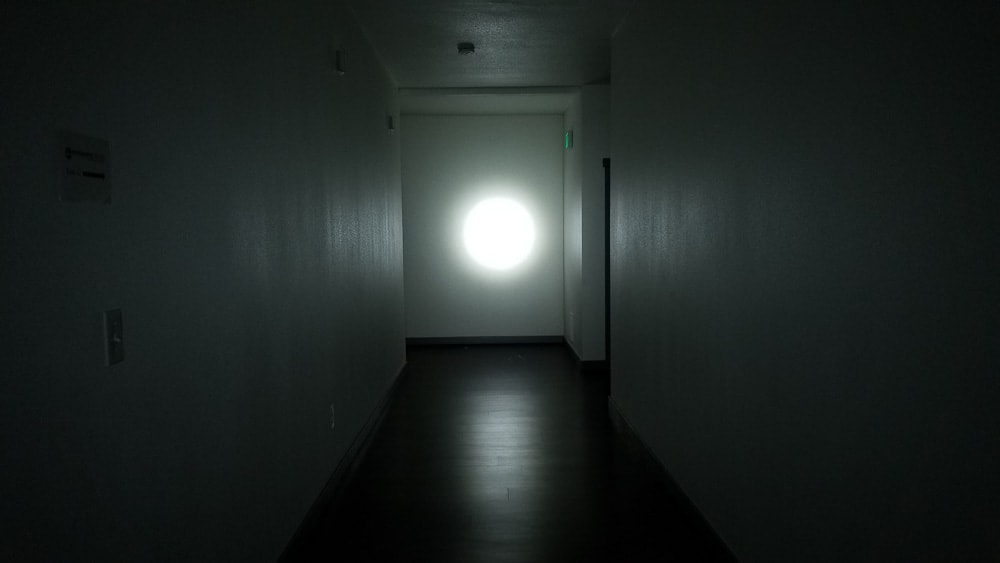
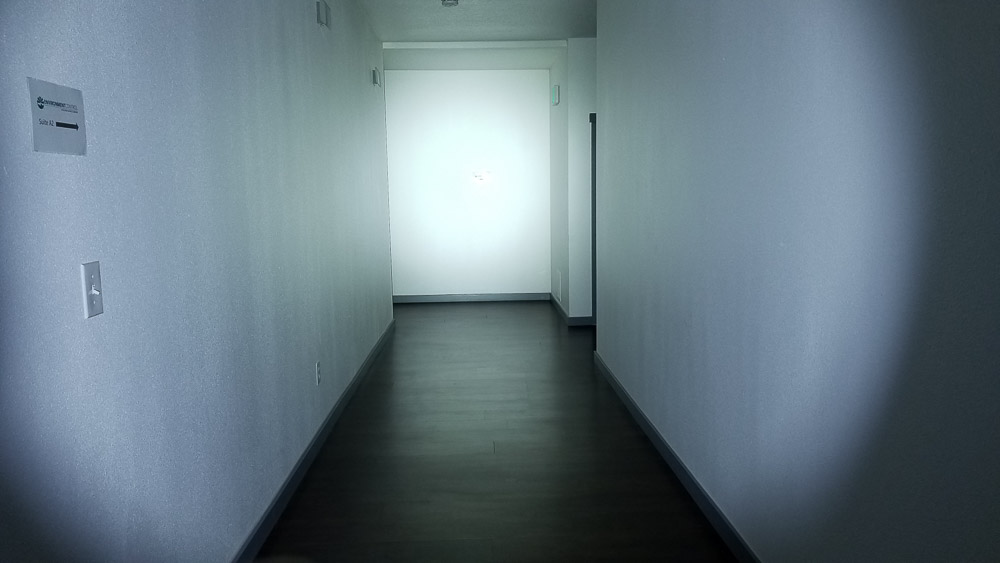
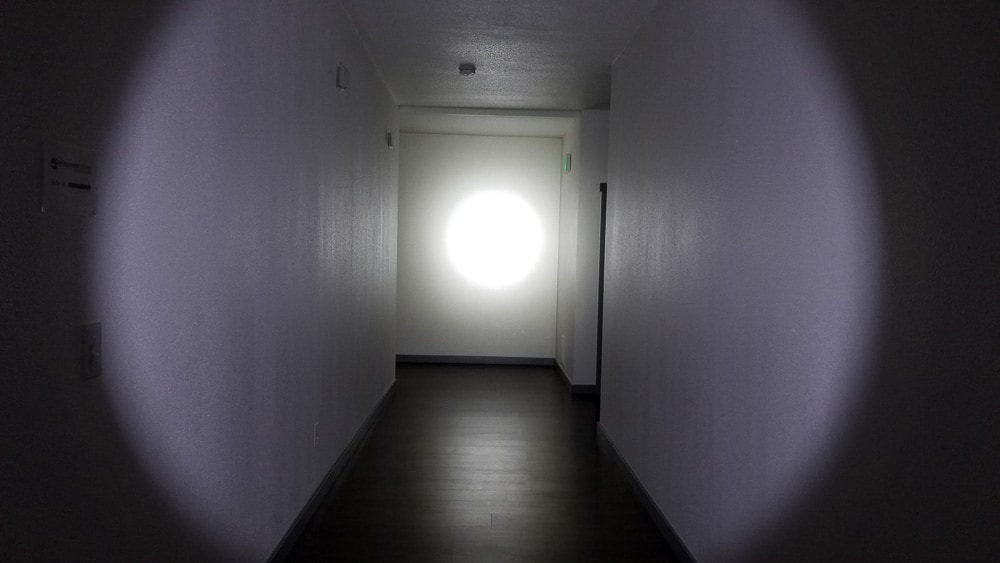
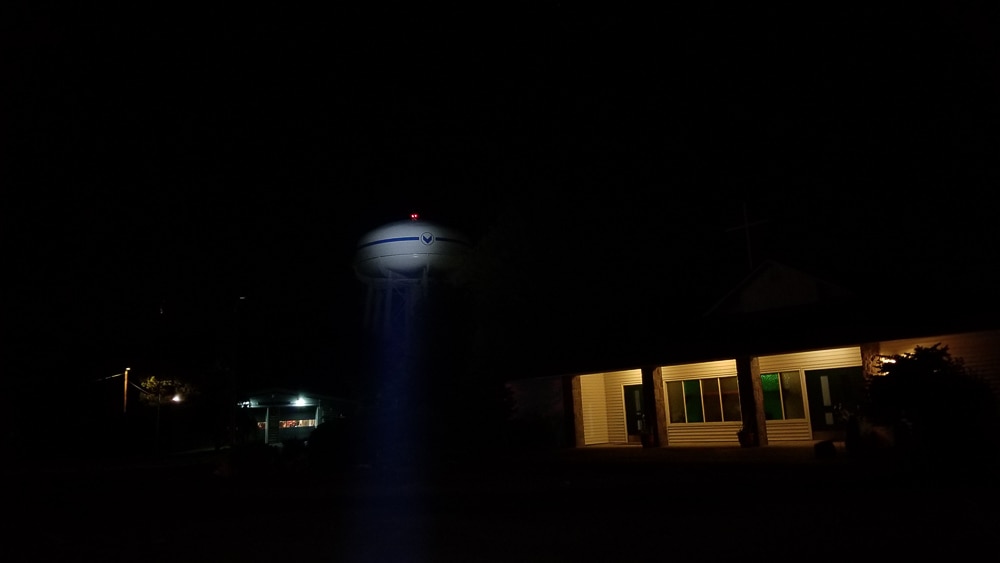

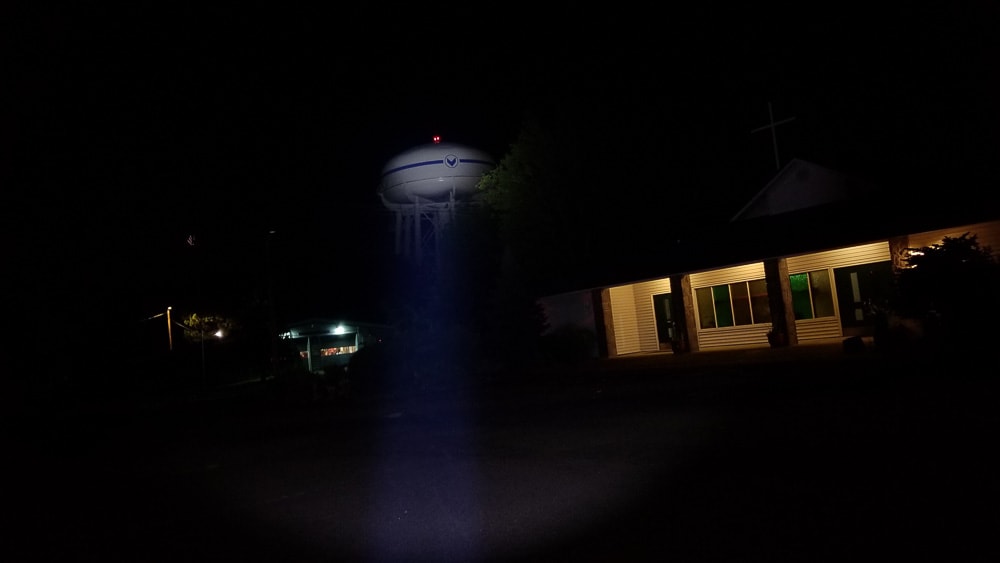
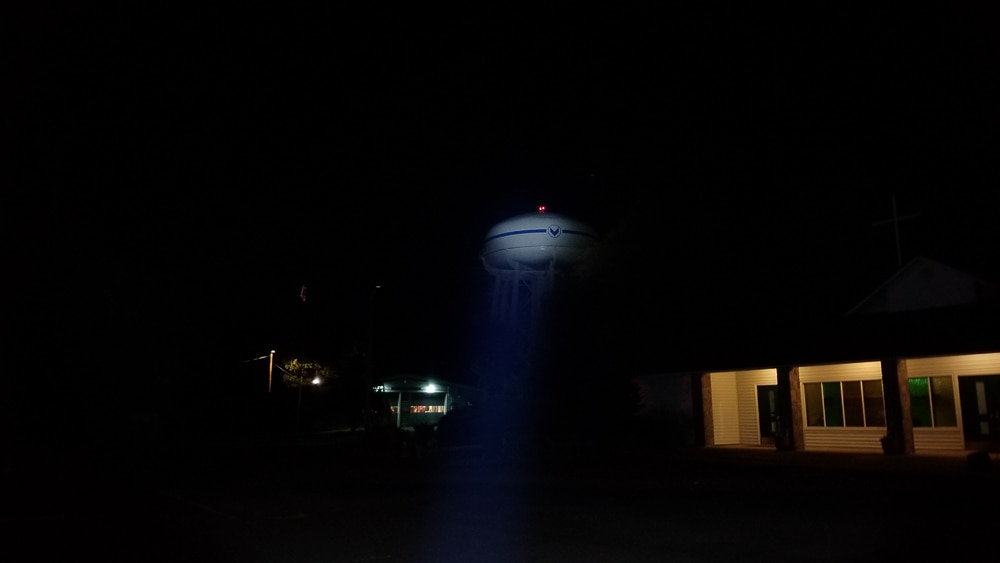
Disclaimer: This flashlight was sent to me for review at no cost by Cyansky. I have not been paid to review, nor have I been holding back on problems or defects.
Final Verdict
Pros
- Fantastic quality, fit and finish
- Included all necessary accessories
- Consistent output and runtimes
- Doesn’t get too hot
- Excellent throw
- Zirconium breaking tips
- Non-proprietary battery
Cons
- Slow charging
- No tactical ring?
- No instant access to turbo and/or strobe
Explanation on star ratings:
1: Avoid: my phone flashlight would be a better choice – 2: Poor: significant defect or issues, much better options available at the same price – 3: Average: some defects or issues – 4: Good: recommended (minor issues) – 5: Great: highly recommended

4.5 stars: ★★★★⋆
When designing the K3, it’s almost like Cyansky clandestinely rummaged through the parts bins at Acebeam and Fenix, took parts from the L series and PD/TK series lights, and stuck them together and voila, we get the K3! In all seriousness, this is a great concept and really the only competition to Acebeam’s L series tactical throwers.
Yep, I said tactical, and although some purists would scoff over the fact the K3 is missing some truly tactical features like instant access to turbo or strobe, uber-amounts of accessories, or the street cred of Olight, Acebeam, Nitecore, and Fenix, it still has enough to be tacticool at least. You get excellent throw for a 40 mm reflector at output levels on par with SST40’s. It throws better than an XP-L HI and gets a little brighter than a Boost HX, sort of the best of both worlds! It will run for long periods without melting your hand, which is important for professionals.
I think it’s a great step in the right direction for up-and-coming Cyansky, and I give them a lot of credit for being bold enough to use the relatively untested SFT-40-W in a mass-produced light. The only negatives I can think of is the lack of visual LVP notification and the aforementioned missing tactical features (no tactical grip ring?) found on competing lights, and I think it could be driven a bit harder, but that aside, this is a fantastic flashlight worth taking a look at. 4.5 stars for the Cyansky K3.
Buy the Cyansky K3 here:
The Cyansky has been replaced by the K3 v2. See our Cyansky K3 v2 review
1lumen selects and reviews products personally. We may earn affiliate commissions through our links, which help support our testing.